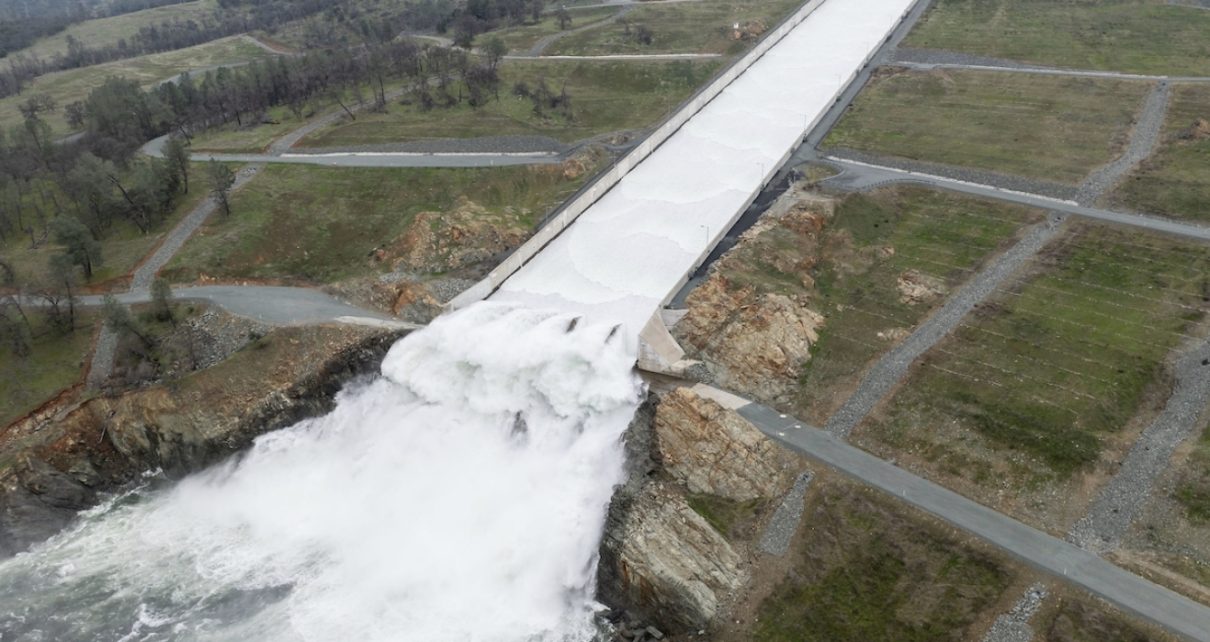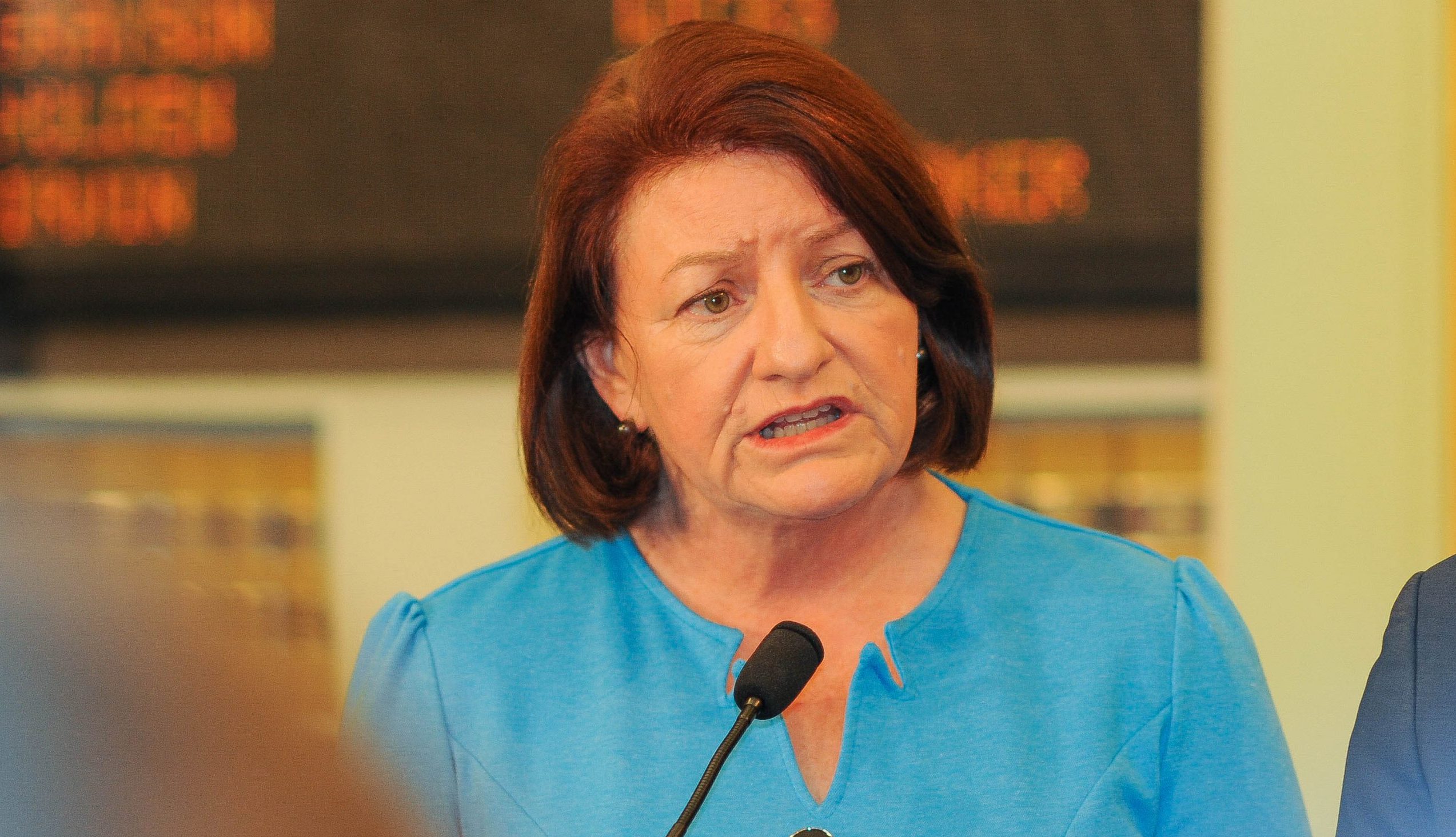
Lake Oroville Spillway in February 2024 (Photo: California DWR)
Lake Oroville Reaches Full Capacity For Second Year In A Row
‘What California really needs to do is to hold back on environmental releases’
By Evan Symon, May 8, 2024 2:45 am
The California Department of Water Resources announced on Tuesday that Lake Oroville in Butte County has reached it’s full capacity, becoming the second year in a row that it has reached that level and quelling drought fears for at least the near future.
At the beginning of the decade, Lake Oroville was far below it’s capacity of 900 feet mean sea level (MSL). In May 2020, the water level was at 800 feet. However, by the end of the year, it had gone down to 700 feet. By September 2021, it was near the bottom, sitting below 650 feet. Hydro power coming from the dam pretty much stopped as a result. While water restrictions and selective usage somewhat helped in 2022, it wasn’t until the atmospheric river storms of early 2023 brought the Lake out of the drought and back up to full pool in only a few months. Lake Oroville literally went from below 30% capacity in the winter of 2022 to 100% capacity by the Spring.
Drought conditions were erased throughout 2023, with California becoming completely drought free for the first time since 2020 in November 2023. While many scientists had warned that it was just a one-time fluke, rains returned across the state once again earlier this year. While there was some destructive flooding, it also meant that reservoirs were filled up once again, with a steady supply of water coming in through snowmelt. Groundwater levels also bounced back for the first time in 4 years.

At Lake Oroville, California’s second largest reservoir and the most critical reservoir in the water system, the CDWR announced on Tuesday that Lake Oroville reached full capacity this month. Officials noted that, even if 2025 turns out to be a dry year, the amount of water in Lake Oroville, as well as snowmelt coming in through the rest of the year, the lake will have a sufficient enough water supply to give to residents through the next year at least.
“We experienced a string of drought years, starting in 2020 through 2022. Since that time, we have seen that extreme weather shift from very dry to wet conditions,” said State Water Project Operations Manager Molly White on Tuesday. “Lake Oroville is the largest reservoir for the State Water Project, it provides adequate and sufficient water supply but also provides additional storage that we will be able to carry into 2025, should next year be dry.
“Lake Oroville reaching its maximum capacity didn’t always seem like a possibility for this year. It wasn’t looking great at the beginning of the water year. It started out very warm and dry. Here we are, certainly Mother Nature turned the corner and provided a lot of good snowpack and run off into the lake that we have been able to fill.”
The remarkable turnaround, from the barren reservoir being the symbol of the California drought only three years ago, to being 128% of it’s historical average today, proved to many in the state on Tuesday that California can bounce back climate wise and can sustain it should they play it smart.
“It wasn’t just the high amount of rain, but it was the state, as well as local municipalities, realizing they needed more storage space and better conservation methods during the last drought, the bad one, ” explained Jack Wesley, a water systems consultant for farms and multi-family homes, to the Globe on Tuesday. “Well, the two years of heavy rain plus those measures pushed Lake Oroville to be full again in only a few years.”
“But now the state needs to play it smart. Locally, they have tried and true emergency measures on the books now in case things get bad again, so we have that buffer. We also have more storage space and better methods of how to use the water supply, so there is another buffer. But what California really needs to do is to hold back on environmental releases, or at least limit the number of them, during drought years going into the future. Everything is at capacity and water needs to go out to help fish? Fine, two birds with one stone. But if there is not enough water from agriculture or urban use, then we need to figure the most precise way to limit such releases, as it is just a waste of freshwater otherwise. The releases in 2020 and 2021 proved that.”
“California needs those buffers going forward. Especially at reservoirs like Oroville that also help generate electricity. In fact, since the state is trying to go green, new reservoirs being built need to have hydroelectric dams going in to help build up green energy, at least where it is feasible. But that’s a conversation for another day.”
“The big thing is that reservoirs are filled once again, and, at least for the next year or two, if California goes drought again, we’ll have enough. We’re back to where we should be. The goal should be to stay there for as long as possible and get water to those who need it.”
- Bill to Require Law Enforcement Disclosure if AI Was Used To Help Write Reports - August 7, 2025
- Gov. Newsom Files FOIA Request To ‘Expose True Cost’ Of L.A. Federal Troop Deployment for Anti-ICE Riots - August 6, 2025
- California Redistricting: How Newsom’s Plan Will Demolish Hard Fought GOP Gains - August 6, 2025





Buh,bye precious water. Off to the ocean it will go.
So I ask this, why is it Newsom does not declare a state of emergency for water scarcity?
Make it a priority and maybe then we could fix our water issues in this state. It is not gor lack of rain.
The Climate Fraudsters said this was not possible. It would take years to refill this and other reservoir. Their track records on predictions is horrible. Yet they are allowed to move forward with enriching their friends with funding for wind farms (mass slaughter of birds and whales (off shore farms) & mass quantities of unrecyclable blades) and solar farms (rare earth minerals for panels, also waste issues as the panels are upgraded). The problem with this Country and State is the total lack of accountability. No one is held to account for the terrible decisions that are made based on fraudulent science and outright lies. Has anyone been held to account for the man made Klamath River disaster? Don’t hold your breath.
Here is an idea, let’s build, build, build in California.
Let’s bring in even more high-birth rate “new residents” and expand exponentially.
Fibonacci numbers rule our demographics again.
I spent almost my entire state employment at DWR. In the 1980’s it was lead by top notch water knowledgeable directors. Then term limits necessitated termed out politicians find other jobs. Hence, governors began appointing politicians instead of agency specific knowledgeable to directorships. My once beloved DWR began its downward slide into politics instead of its true job; water.
Then we started wasting money writing contracts not just for construction, and operation and maintenance of the State Water Project but for universities to study the effects of shrimp on treadmills and other eco centric projects. Hence, Ali g with the feds, we dump almost 50% of our storage water out to the ocean, supposedly to save a 2” fish, the Delta Smelt, a major food source for the salmon. Then we start removing dams and kill off a the salmon we were supposedly trying to save. The dam removal is an ecological disaster but hey, Indians can fish again.
Stupidity reigns in California, with sending fresh water out to the ocean, which “environmentalists” and politicians claim will rise due to “Climate Change”. Anyone with a grain of common sense can see through that!
On a trip to Oregon a couple of weeks ago, we saw that Shasta is completely full as well. Wish we had anyone in Sacramento who wanted to preserve the excess water of 2023-2024. Alas, that takes common sense and brains, both being in very short supply in our capitol.